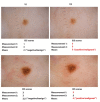UV Irradiation of Nevi: Impact on Performance of Electrical Impedance Spectroscopy and a Convolution Neural Network
- PMID: 36534529
- PMCID: PMC9681178
- DOI: 10.5826/dpc.1204a164
UV Irradiation of Nevi: Impact on Performance of Electrical Impedance Spectroscopy and a Convolution Neural Network
Abstract
Introduction: UV irradiation of nevi induces transient melanocytic activation with dermoscopic and histological changes.
Objectives: We investigated whether UV irradiation of nevi may influence electrical impedance spectroscopy (EIS) or convolution neural networks (CNN).
Methods: Prospective, controlled trial in 50 patients undergoing phototherapy (selective UV phototherapy (SUP), UVA1, SUP/UVA1, or PUVA). EIS (Nevisense, SciBase AB) and CNN scores (Moleanalyzer-Pro, FotoFinder Systems) of nevi were assessed before (V1) and after UV irradiation (V2). One nevus (nevusirr) was exposed to UV light, another UV-shielded (nevusnon-irr).
Results: There were no significant differences in EIS scores of nevusirr before (2.99 [2.51-3.47]) and after irradiation (3.32 [2.86-3.78]; P = 0.163), which was on average 13.28 (range 4-47) days later. Similarly, UV-shielded nevusnon-irr did not show significant changes of EIS scores (V1: 2.65 [2.19-3.11]), V2: 2.92 [2.50-3.34]; P = 0.094). Subgroup analysis by irradiation revealed a significant increase of EIS scores of nevusirr (V1: 2.69 [2.21-3.16], V2: 3.23 [2.72-3.73]; P = 0.044) and nevusnon-irr (V1: 2.57 [2.07-3.07], V2: 3.03 [2.48-3.57]; P = 0.033) for patients receiving SUP. In contrast, CNN scores of nevusirr (P = 0.995) and nevusnon-irr (P = 0.352) showed no significant differences before and after phototherapy.
Conclusions: For the tested EIS system increased EIS scores were found in nevi exposed to SUP. In contrast, CNN results were more robust against UV exposure.
Keywords: UV irradiation; convolution neural network; dermoscopy; electrical impedance spectroscopy.
©2022 Winkler et al.
Conflict of interest statement
Competing Interests: None.
Figures





Similar articles
-
Impact of UV-irradiation on electrical impedance spectroscopy of benign nevi: study protocol for a prospective, controlled, clinical study.BMJ Open. 2017 Nov 8;7(11):e018730. doi: 10.1136/bmjopen-2017-018730. BMJ Open. 2017. PMID: 29122805 Free PMC article.
-
Ultraviolet radiation of melanocytic nevi: a dermoscopic study.Arch Dermatol. 1998 Jul;134(7):845-50. doi: 10.1001/archderm.134.7.845. Arch Dermatol. 1998. PMID: 9681348
-
Evaluation of electrical impedance spectroscopy as an adjunct to dermoscopy in short-term monitoring of atypical melanocytic lesions.Dermatol Pract Concept. 2016 Oct 31;6(4):1-6. doi: 10.5826/dpc.0604a01. eCollection 2016 Oct. Dermatol Pract Concept. 2016. PMID: 27867738 Free PMC article.
-
The morphologic universe of melanocytic nevi.Semin Cutan Med Surg. 2009 Sep;28(3):149-56. doi: 10.1016/j.sder.2009.06.005. Semin Cutan Med Surg. 2009. PMID: 19782938 Review.
-
Melanocytic nevi with special features: clinical-dermoscopic and reflectance confocal microscopic-findings.J Eur Acad Dermatol Venereol. 2014 Jul;28(7):833-45. doi: 10.1111/jdv.12291. Epub 2013 Oct 31. J Eur Acad Dermatol Venereol. 2014. PMID: 24171788 Review.
References
LinkOut - more resources
Full Text Sources
